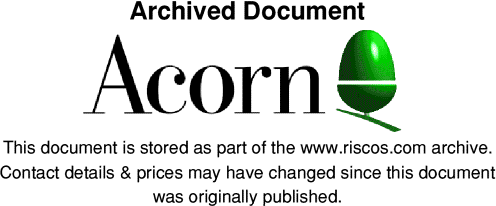
15/02/95 Pocket Book II February 1995.
Since its launch in 1992, thousands of Pocket Books have been acquired by schools around the world. This success is due to the combination of in-built, ready-to-run, multitasking applications carefully designed both in terms of ergonomics and of relevance to curriculum requirements.
Pocket Book II applications provide all the basic tools necessary for organising and recording ideas, notes and data: Write (the fully-functional word processor with its in-built spelling checker), Abacus (the Lotus 1-2-3 compatible spreadsheet), Calc (the scientific calculator), Cards (the database) and Time.
All Pocket Books can transfer their data via the optional desktop link to the user's desktop system (whether PC, Apple or Acorn) for further analysis or presentation.
Pocket Book II adds to this with Schedule (a diary and scheduling application) and Plotter (a graph plotter which removes the need for a separate graphical calculator).
Pocket Book II has a screen which is twice the area of the Pocket Book, and the bigger model has a memory of 512K.
Performing the tasks that a laptop computer is typically used for, but at a fraction of the cost, and with the ability to fit neatly into a pocket, satchel or school bag, Pocket Book is the ideal purchase.
Pocket Book II specification
Size:
165 mm x 85 mm x 22 mm
Weight:
275g including batteries
Screen:
480 x 160 graphics screen, up to 80 characters by 17lines. High contrast, retardation film LCD
Internal ROM memory:
2MB containing multi-tasking, windowing operating system, and software applications
Internal RAM memory:
256K or 512K
External expansion:
Two Solid State Disks (SSDs), 63 mm x 43 mm x 6 mm.Flash SSDs require no battery back-up; capacity up to 2MB.RAM SSDs have their own lithium battery capacity upáto 1MB
Processor:
16-bit NEC V30H (80C86 compatible), 7.68MHz
Sound:
Loudspeaker, with DTMF auto-dialling and digital sound playback; microphone for digital sound recording
Power:
Two AA-size alkaline batteries, giving approximately 80 hours of continuous use (without using expansion upgrades), or 2 to 4 months of typical usage; standard lithium back-up battery protects RAM while main batteries are changed; optional external AC Mains Adaptor (AHA35)
Keyboard:
58-key, QWERTY layout, computer-style keyboard; 8 touch-sensitive buttons for application selection
Operating temperature:
0░-50░ C
Communications options:
Fast serial interface (1.536Mbits/sec)
A-Link (AHA30) to allow communication with an Acorn 32-bit computer and provide direct file access
Parallel Link (AHA31) to allow direct printing to most parallel printers
PC Link (AHA36) or M Link (AHA37) to allow communication with PC compatibles or Apple Macintosh
Manual:
Comprehensive, easy-to-use User Guide
Optional:
Programmer's (OPL) Guide
Built-in applications:
Cards:
flat-form database for storing information and other data (anything from a biology glossary to details of the planets)
Write:
fully featured word processor with outlining, variable font sizes, page layout support, and partial WYSIWYG
Schedule:
manages appointments, diary, anniversary and to-do requirements, with alarms
Abacus:
fully featured spreadsheet, compatible with Lotus 1-2-3, and with graphing facilities
Spell:
spell checking, dictionary and thesaurus; also accessible from within Write
Time:
sets the time, date and home city
Plotter:
plots and traces mathematical equations (Cartesian, polar, parametric, etc)
World:
world times, atlas, dialling codes, distances, etc
Calc:
scientific calculator
Record:
sound and voice recorder
OPL Editor:
edits and runs OPL programs; OPL is a language similar to BASIC
*A-Link requires RISC OS 3 (version 3.10 or later)